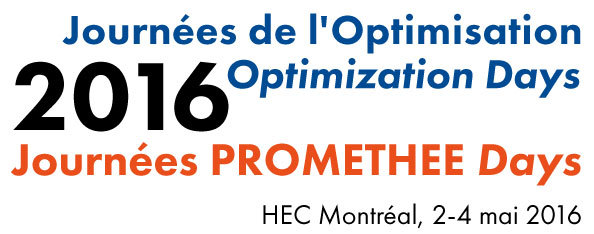
Journées de l'optimisation 2016
HEC Montréal, Québec, Canada, 2 — 4 mai 2016

TB4 Clustering
3 mai 2016 15h30 – 17h10
Salle: Gérard-Parizeau
Présidée par Claudio Contardo
4 présentations
-
 15h30 - 15h55
15h30 - 15h55A hierarchical graph clustering algorithm based on the co-occurrences of nodes following consensus clustering
This article works with computational methods used to analyse complex systems in order to identify communities in networks. The proposed algorithm can identify partitions on different scales and down to the core communities of a graph. This is achieved by a hierarchical graph clustering method based on the co-occurrence of nodes in the same community after repeated clustering using the Louvain method. The results are analyzed using both LFR random graphs and classical graph theory examples.
-
 15h55 - 16h20
15h55 - 16h20An iterative algorithm for the solution of some highly degenerate combinatorial optimization problems: Applications in clustering
We present an iterative algorithm for the solution of some combinatorial optimization problems presenting extremely high degrees of degeneracy. We illustrate the use of our algorithm to solve a classical clustering problem arising in data mining. The newly proposed approach can scale and solve problems two orders of magnitude larger than with the state-of-the-art solver.
-
 16h20 - 16h45
16h20 - 16h45Less is more approach: Capacitated clustering problem
Heuristic search named 'Less is more' has been recently proposed: find the minimum number of ingredients that make some heuristic more efficient than the currently best. It is represented by Variable neighborhood search, where simple neighborhood types are used for both, shaking and local search. This approach is successfully applied in solving Capacitated Clustering Problem.
-
 16h45 - 17h10
16h45 - 17h10Bi-objective variable neighborhood search for franchise location
We present a bi-objective model for franchise location which is aimed at maximizing the proximity between the franchises and the client locations and maximizing the franchise dispersion in order to avoid cannibalization. We have developed several variants of the Variable Neighborhood Search metaheuristic in order to approximate the Pareto front. Extensive computational experiments are presented.
